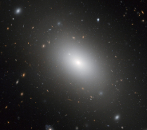
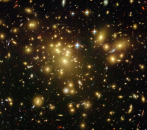 |
|
Fig. 0:
Images of a galaxy (NGC 1132, left) and a galaxy cluster (Abell 1689, right) taken with the ESA/NASA Hubble Space Telescope. Observed in optical light, these systems look very different, as a galaxy cluster may contain hundreds or even thousands of galaxies. On the other hand, the X-ray emission from these systems looks remarkably similar.
Credit: NASA, ESA, and the Hubble Heritage (STScI/AURA)-ESA/Hubble Collaboration
Credit: NASA, ESA, L. Bradley (JHU), R. Bouwens (UCSC), H. Ford (JHU), and G. Illingworth (UCSC)
|
 |
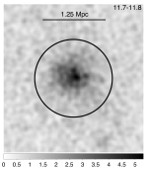
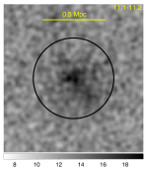 |
|
Fig. 1:
Stacked X-ray images of the emission around the central galaxies of rich galaxy clusters (left) and lower mass galaxy groups (right). These are two of the twenty produced in this study. In both images, the black circle indicates the radius "R500", which roughly matches the size of the dark matter halo. The X-ray emission is centrally concentrated but clearly extends out to a significant fraction of this radius. The numbers in the top right of each image denote the stellar mass of the central galaxies (log M_star; see Fig.2) which were stacked. As the rulers show, R500 is about 2.5 times larger (and the mass about 15 times larger) for the clusters than for the groups. However the radial distribution of emission is similar in the two images.
|
 |
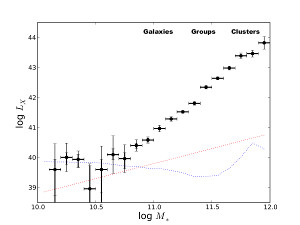 |
|
Fig. 2:
Average X-ray luminosity for each of the 20 stacked images as a function of the stellar mass of the central galaxy. At higher masses the relation between the two is a power law (a straight line in this plot). For the seven data points at lowest mass, the X-ray emission from the hot gas is too faint to measure reliably, and the X-ray signal is also contaminated by emission from X-ray binaries in these galaxies - their estimated luminosity is shown with the blue and red dotted lines, corresponding to high-mass X-ray binaries and low-mass X-ray binaries respectively.
|
|  |
While galaxies, with their billions of stars, may seem unfathomably large, the Universe contains even bigger objects. Clusters of galaxies are the largest known equilibrium structures. They can contain many hundreds of galaxies and a total mass thousands of times that of the Milky Way system. Galaxies and clusters appear very different when viewed in optical light (see Fig. 0), but computer simulations such as the Millennium Simulation suggest that their dark matter distributions should look very similar. The technical term for this is 'self-similarity', which in this context means that the dark matter halos of galaxy clusters are more or less just scaled-up versions of those which surround galaxies.
Both galaxies and galaxy clusters (and their dark matter halos) are expected to be suffused with hot gas as well. This gas, which is heated to temperatures of millions of Kelvin, emits high-energy radiation and can be studied with X-ray telescopes like ROSAT and XMM-Newton. Studies of dozens of galaxy clusters show that the X-ray luminosity of the hot gas increases with the total mass of the cluster. Independently, studies of dozens of elliptical galaxies have shown that the X-ray luminosity of their hot gas increases with the stellar mass of the galaxy. These two correlations connect X-ray luminosity to two different quantities (total mass for clusters, stellar mass for galaxies), and have typically been measured in different ways for the different types of object.
A team at MPA has now combined these two relations using an archived X-ray map of the whole sky. They analysed emission around a sample of 250,000 galaxies in the ROSAT All-Sky Survey - more than a thousand times the number used in any previous galaxy study - and carefully combined the X-ray emission from several thousand similar mass galaxies into a set of average images in a process known as "stacking". Example stacked images are shown in Figure 1 for two different stellar masses. By eye, the distribution of the hot gas in galaxy clusters looks just like a scaled-up version of that around much smaller galaxies. The full results are shown in Figure 2, which shows the relation between mean X-ray luminosity and stellar mass. This relation follows a straight line all the way from the individual galaxy regime (small masses) up to the rich cluster regime.
However, a more detailed analysis shows that the slope of this line is steeper than would be expected if the hot gas were perfectly self-similar. This is probably due to a combination of effects, with a major contribution coming from heating by supermassive black holes at the centres of galaxies. As gas falls into a supermassive black hole, it loses large amounts of energy which are pumped into the hot gas atmosphere surrounding the galaxy. This is known "active galactic nucleus (AGN) feedback" and is thought to be important in the formation of both galaxies and galaxy clusters. AGN feedback has a bigger effect on less massive systems, lowering the X-ray luminosity of galaxies much more than that of clusters.
This effect makes the relation in Figure 2 steeper than it would be if the hot gas were perfectly self-similar. The new measurements of X-ray luminosity over a broad range of masses gives a powerful clue to help understand AGN feedback. Comparing these measurements against predictions from numerical simulations, the MPA team showed that gentle, 'self-regulated' AGN feedback is preferred over more violent input of energy.
Detailed comparison with previous measurements show that the new results are perfectly consistent with previously measured scaling relations for galaxies, as well as with scaling relations measured for optically selected samples of galaxy clusters. This suggests that a single relation can indeed describe both types of object. Studies of scaling relations for galaxy clusters selected by their X-ray properties have typically shown a similar slope but a systematically higher mean brightness at given total mass. This is most likely a reflection of the diversity of X-ray properties among clusters of a given total mass, which may have been underestimated in earlier work.
Finally, this work complements a similar analysis performed for the same galaxies and galaxy clusters using data from the Planck satellite. That analysis used the shadows which hot gas atmospheres cast on the cosmic microwave background to measure the total thermal energy of the hot gas, as opposed to its X-ray luminosity, finding this to scale with mass self-similarly. Combining these two results implies that a large reservoir of hot gas surrounds galaxies, but is too rarefied as a result of AGN feedback to emit strongly in X-rays. This would resolve the long-standing problem of the location of the baryons which "should" be associated with the galaxies but had not previously been detected directly.
Mike Anderson, Massimo Gaspari, Simon White (MPA), Wenting Wang (Institute for Computational Cosmology, University of Durham), Xinyu Dai (Department of Physics and Astronomy, University of Oklahoma)
Publications:
Anderson, Michael E.; Gaspari, Massimo; White, Simon D. M.; Wang, Wenting; Dai, Xinyu Unifying X-ray scaling relations from galaxies to clusters,
 MNRAS Volume 449, Issue 4, p.3806-3826 (2015) MNRAS Volume 449, Issue 4, p.3806-3826 (2015)
Planck Collaboration Planck intermediate results. XI. The gas content of dark matter halos: the Sunyaev-Zeldovich-stellar mass relation for locally brightest galaxies,
 Astronomy & Astrophysics, Volume 557, id.A52, 17 pp. (2013) Astronomy & Astrophysics, Volume 557, id.A52, 17 pp. (2013)
|




